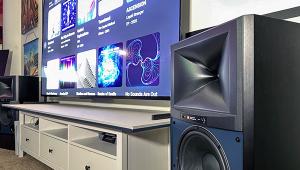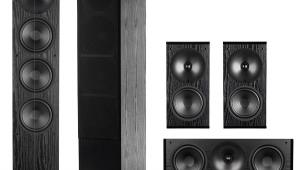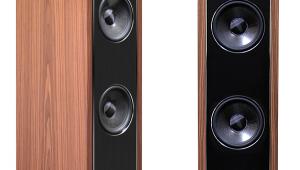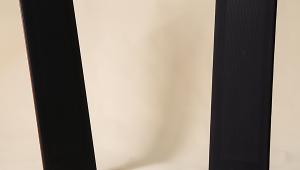Totem Acoustic Sttaf Loudspeakers, Outlaw Audio LFM-2 Subwoofer, and Outlaw Audio RR2150 Stereo Receiver
Home theater is the union of big-screen television and surround sound. Those are the two bedrock principles on which this magazine was founded. So, it may seem heretical to even consider modifying that second requirement. After all, the whole notion of home theater has matured in tandem with advances in both video and surround technology.

But let's face it—the growth of home theater has also been stunted by surround's need for side and/or rear surround speakers. Some folks—whether they're more décor conscious or just less technically conscious—balk at the idea of running the cables. Even the once-uncontroversial requirement for a front center-channel speaker has become more problematic with the rise of flat-panel displays. So now, at least three speakers are getting squeezed out of the soundfield. And then there's the problem of where to put the subwoofer.
How can we reduce home theater from a minimum of 5.1 channels to two channels without losing the immersive feeling that suspends disbelief and pulls us into the story? One answer might be that a nonsurround system can still be, to use a term from ancient history, a hi-fi system.
Another answer is that, while the loss of the soundfield is a sacrifice most home theater buffs would not—and should not—make, there may be situations where substituting a two-channel soundstage might still be adequate for cinematic and musical immersion. A run-of-the-mill two-channel system can't do that, but an exceptional pair of speakers, powered by an amplifier with some oomph behind it, just might.
Finally, here's one more idea: Forget about home theater 2.0 and concentrate on home theater 2.1—in other words, keep the subwoofer. To pull that off, a stereo receiver with a subwoofer output would be helpful.
Meet the Outlaw Audio RR2150 stereo receiver and the Totem Acoustic Sttaf speakers—oh, and the Outlaw LFM-2 subwoofer.
A Stereo Receiver for Home Theater
The Outlaw RR2150 ($599) is one of only two receivers in the Outlaw line, the other being the seven-channel Model 1070 ($899). When readers ask me about surround receivers, I mention only three models, and the 1070 is my midpriced pick. Elsewhere in Outlaw's arsenal, you'll find four seven-channel amps, one five-channel amp, and one monoblock—clearly, this is a company with one foot planted firmly in surround territory. However, they may have chosen just the right moment to plant their other cowboy-booted foot in two-channel territory.
Stereo receivers are usually an undernourished afterthought in most mass-market receiver lines. Integrated stereo amps are more plentiful, but I can count the number of great sub-$1,000 models on the fingers of one hand. And, without a subwoofer output, none of them integrates well into a 2.1-channel system. I was waiting for something like the Outlaw RR2150—and here it is.
Although Outlaw is not known for fancy industrial design, the RR2150's faceplate is like nothing I've ever seen. A half-dozen indented horizontal lines at the left seem purely ornamental. The center is a series of three-stepped subpanels: one for headphone and speaker functions, one for tone controls, and the third for the large blue fluorescent display. A fourth subpanel at the right takes the form of a quarter-circle and includes volume and other controls.
This stereo receiver does not include surround processing. However, it does have a two-channel in/out loop for an external processor, which you might set to downmix surround soundtracks to stereo. Of course, your DVD player will also do that trick—I did it with my Integra DPS-10.5 universal player—so perhaps you don't need a surround processor in your 2.1 system at all.
The receiver also dispenses with video switching—your DTV can handle that. And it has no onscreen menus, something I'd ordinarily consider a serious omission. However, relieved of the complexities of surround—speaker distances, channel calibration, etc.—there's no need for an onscreen display.
The RR2150 does borrow sophisticated bass management from the surround sphere. There are two ways to get bass from a stereo system—add a sub or get what you can out of the two speakers. Outlaw anticipates both needs with various controls.
A back-panel switch lets you choose a subwoofer crossover of 100, 80, or 60 hertz. On the front panel is a knob that boosts bass by 6 decibels at 80, 65, or 55 Hz. It's called Speaker EQ, and, as the name suggests, it's designed to shore up bass response in speakers that are small or otherwise bass restricted, as so many are in this sub-centric era. Also provided are a bass control centered at 50 Hz (+/–6.5 dB) and a treble control centered at 10 kilohertz (+/–9.5 dB).
Even your music player is doubly accommodated with a front-panel minijack and a back-panel USB connection. A variable 0.25-inch headphone jack further suggests that you might use a real pair of big-plug headphones, with the receiver serving as a giant headphone preamp.
Like Falling in Love
Yes, the speaker's model name is Sttaf. Totem explains, "The Sttaf was our first floorstander after our flagship Shaman. To Native Americans, the high shaman uses a sttaf for support and strength." Staff would be the more conventional spelling, but, as it happens, Sttaf Googles beautifully.
Montreal-based Totem Acoustic first got my attention at the 2006 Home Entertainment Show in Los Angeles. It's the kind of show where you can just walk down the halls of the hotel exhibit space and let good sound lure you into demo rooms. The Totem Dreamcatcher speakers caught my attention that way—it was just like falling in love. So, when I began rooting around for a pair of floorstanders to mate with the Outlaw, the Sttafs got the job.
Just 35 inches tall, the Sttaf is visually unobtrusive as a floorstanding speaker. Its footprint is smaller than a lot of speaker stands. The speaker comes without a grille—there aren't even holes to accept a grille—although you can obtain optional Velcro-attachable grilles. Platforms attach to the speaker with supplied yellow-tack instead of bolts. Inside the enclosure, features unseen include dual cross-bracing and the unusual use of borosilicate damping material.
The design is your basic two-way with a back port, including a tweeter (made of silk and other organic materials) that seduced me at first hearing and never disappointed afterward. As I discovered in weeks of full-range listening, the 5.5-inch woofer produces a musically and cinematically meaningful amount of bass, a trait it shares with the Outlaw sub.
The Outlaw LFM-2 sub has a single down-firing 8-inch woofer backed by a 150-watt amp. This is one of many cases where specs can mislead. This subwoofer can really woof. The enclosure isn't very wide relative to its height and depth, allowing it to blend into a room more easily than a square shape.
Music in 2.0 and 2.1
Enjoying a brief vacation from heavy-carton work, I spent nearly a month with the Outlaw receiver running the Totems (with and without the Outlaw sub). Neutrally voiced equipment is always hard to describe. How many words are there for the absence of flaws? The system didn't hit any of the usual trip wires. The midrange sounded like an only faintly less voluptuous cousin of my reference system, clean and unmarred by any obvious edge or coloration. Highs were clear and open, neither strident nor vague.
Bass, without the sub, was plentiful enough to support any kind of music I challenged the Sttafs with. I logged hours and hours before I hooked up the sub. With the sub switched on at an 80-Hz crossover, bass drums became a little more solid, but, otherwise, the sound changed relatively little.
There is no waveguide or recess for the tweeter to hide in. The soundstage remained coherent in many listening positions, not just in the sweet spot. Moving off center did not produce a cupped-hands feeling or a severe drop-off in midrange or high-frequency clarity. In a bare-walled room with lots of side-wall reflection, the lack of a waveguide might have been a liability. In my asymmetrical, clutter-lined space, though, it worked beautifully.
My favorite track sequence on the new David Gilmour CD, On an Island, is "Red Sky at Night," leading into "This Heaven." I loved the way the Totems measured out the richness of the midrange and the sparkle of the high frequencies, both loaded with Gilmour's scrupulously woven tapestry of guitar parts. It's even the man himself playing sax on "Red Sky." The segue into "This Heaven" changes the mood from heavenly to earthly with a loping beat that's recorded with plenty of down-and-dirty room leakage—it's the refreshing opposite of the other tracks' obsessively clean mixes. With a system free of obvious coloration, like this one, the mood shift is dramatic and delightful.
The 80-Hz crossover divided the lower parts of the string and rhythm sections so neatly that I wasn't sure what was coming out of the sub and what was coming out of the speakers—I actually had to feel the sub's down-firing driver with my fingers. Sure enough, it was trembling under the cellos and basses and pumping out the bass drum with virtually no false upper harmonics attached to its deep, true pitches.
Thelonious in Action took me out of Gilmour's houseboat studio and into New York's Five Spot, circa August 1958. The famous quartet with John Coltrane had dissolved by then, but I love this later recording with Johnny Griffin on tenor sax. It does a nice job of rendering the instruments cleanly, while adding a smidgen of some club ambience, which was something the Totems—specifically the left Totem—made especially audible with the sax. The microdynamics of Thelonious Monk's piano were well preserved, which is a good thing, since this release featured the debuts of two then-new compositions, "Light Blue" and "Coming on the Hudson." I closed my eyes, and I was there.
Cinema in 2.1
The Outlaw RR2150 has no cinema re-EQ circuit, but I thought it was interesting that the menu of Final Destination 3 stated, "Audio optimized for DVD—no re-equalization required." If only all disc releases were so considerately labeled.
 A roller-coaster disaster roars through the first 20 minutes. As it coasted toward doom, I knew I must have been missing some cool surround-panning trajectories. Yet, hearing the soundtrack's volume ups and downs downmixed to stereo also made me realize how important dynamics are to the buildup and release of cinematic tension. The screams in the sizzling tanning-salon massacre would have been misanthropically gratifying even in mono.
A roller-coaster disaster roars through the first 20 minutes. As it coasted toward doom, I knew I must have been missing some cool surround-panning trajectories. Yet, hearing the soundtrack's volume ups and downs downmixed to stereo also made me realize how important dynamics are to the buildup and release of cinematic tension. The screams in the sizzling tanning-salon massacre would have been misanthropically gratifying even in mono.
Running Scared is loud and sadistic, with a good surprise ending. The mob plot starts with a prolonged shootout that might be interesting in surround but was just fatiguing in stereo. Bass content is minimal, making gunplay mainly a jarring midrange phenomenon. A hockey-related torture scene follows the puck from between the torturer's legs straight toward the victim's face. Without back-to-front action, the stereo downmix failed to support the visuals. But an earlier scene with a blowtorch being brandished as a weapon depends more on swooshing side-to-side action, and the speakers rendered this quite effectively.
Syriana is punctuated early on by a street bomb that the LFM-2 sub delivered with a clean thunk. The soundtrack was far from the first to impress me with low synthesizer pulses—the most reliable (and cheapest) means of injecting menace into a movie score. But there was one in-between moment during a plane landing when the pulses became almost subliminal. Any higher in volume, and it would have ruined the moment; any lower, and I wouldn't have noticed the sound.
As with another George Clooney movie, Good Night, and Good Luck, the vocal tracks are recorded in a rich but subtle manner, befitting a movie where an actor/producer cares deeply about the script. I played the movie with an air conditioner running. This was unavoidable—it was early August, the first day of a mind-bending heat wave. Yet little of the dialogue eluded me, despite the absence of a center-channel speaker. And, with the Empire State Building's night-lights having gone dark to spare the summer-stressed power grid, I felt virtuous for running only two channels and a sub.
The recurring sonic highlight of The Pink Panther—the remake with Steve Martin—was Henry Mancini's original "The Pink Panther Theme." It takes various forms, some of which lift it out of the 1960s milieu of the original film, but the best reiterations are the big-band horn charts that sweep across the soundstage like some kind of hip, bejeweled royalty. The Sttafs civilized the brass textures with a satiny feeling. When Beyoncé, who stars, sang "Check on It" over the end credits, the sub neatly percolated the hip-hop beat.
The Results Are In
When I sat down to ponder the results of the great 2.1 experiment, I realized that I missed surround more with movies than I did with music. That was no surprise, given that music is still primarily a two-channel medium, whereas every filmmaker with any kind of budget—barring mono-addicted Woody Allen—thinks in surround. And, even in movies, I could go for long stretches without missing surround before finally hitting some obvious front-to-back visual cue that had lost its sonic counterpart.
My feeling about the equipment itself was unambiguous. The Totem Acoustic Sttafs are truly reference-quality speakers and are as close to ideal for music (the hardest test) as anything I've ever heard. Outlaw's RR2150 stereo receiver has quality to match its uniqueness. Both products are neutral, the greatest praise I can give any audio gear. And the Outlaw LFM-2 belongs on my short list of best budget subs.
If you're reading this magazine, you're probably into surround. But you might know someone who's not—someone who loves movies and music but can't handle the extra cables. Do your friend a favor and recommend this system. Also, a lot of surround buffs have a secondary music system in an extra bedroom, a place to store old vinyl and hide out from the world. If you're contemplating that kind of system and need to stay within budget, here it is. Sometimes 2—or 2.1—can be a magic number.
* Audio editor Mark Fleischmann is also the author of the annually updated book Practical Home Theater (www.quietriverpress.com).





























































